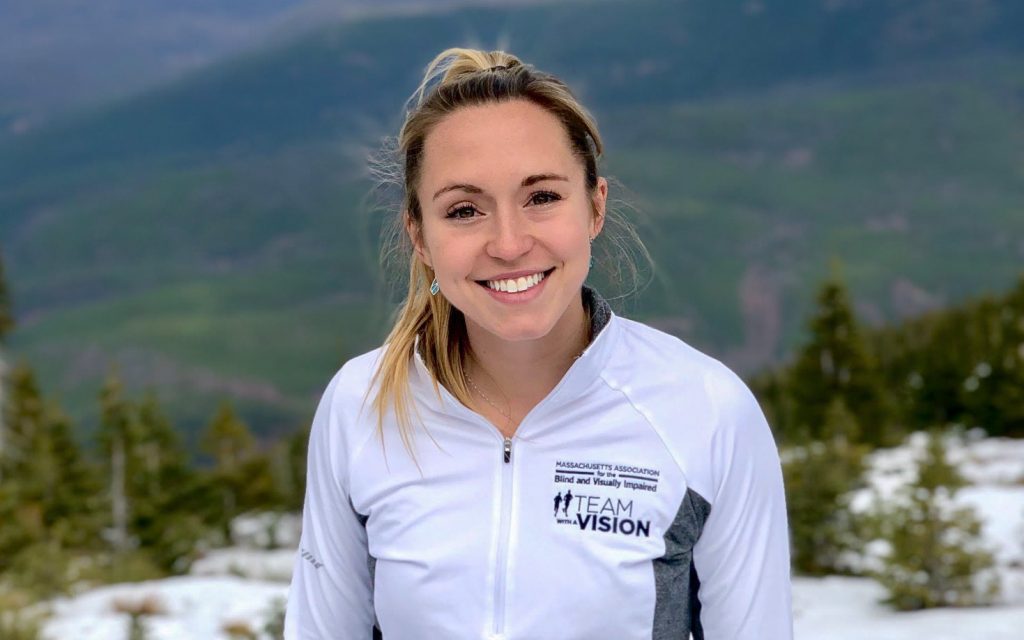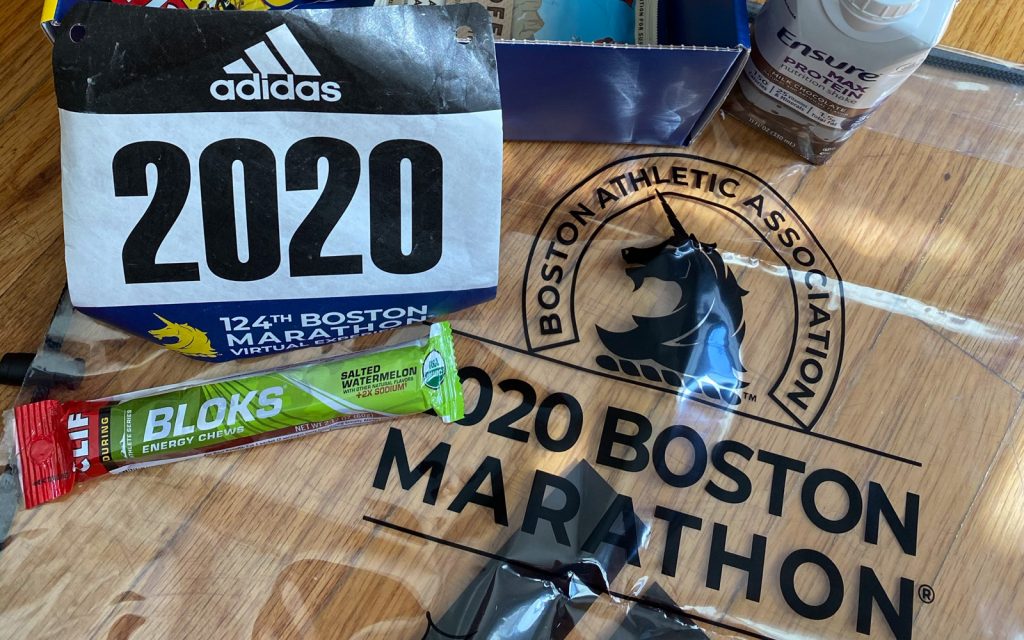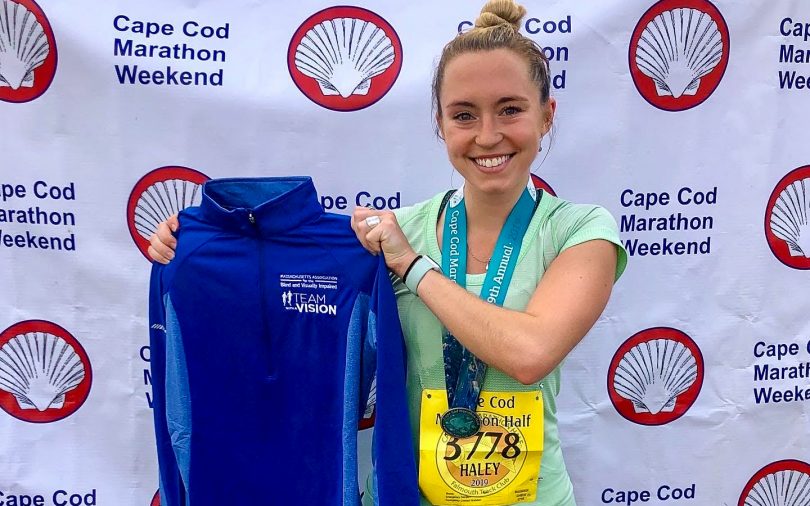By Mikayla Heiss
BU News Service
BOSTON — Passing co-workers offered condolences as Haley Leishman walked through the Ivy Street School on March 13. As she strode through the facility devoted to helping young people with learning and behavioral health challenges, Leishman was confused. “I hadn’t even checked the news at that point,” she said. A surreal feeling settled over the charity and sighted guide runner as the reality sunk in – the 2020 Boston Marathon was postponed.
“It felt really strange,” Leishman said. “I was like, ‘Wait, why is it postponed? Nothing’s really happening yet.’”
When case numbers rose and social distancing took hold of the state of Massachusetts, Leishman began to understand. The announcement of a virtual marathon soon seemed inevitable, but Leishman wasn’t ready to give up.
The virtual Boston Marathon will be an unprecedented experience. Runners will chart their own course, and crowds will be absent. But Leishman’s running career has never been straightforward, full of twists and turns, including collapsed lungs at birth, foot surgeries, sighted guiding and an unexpected opportunity to run in the marathon. Hard work and a commitment to the community push her toward breaking through the printed-out tape at the finish line.
After her time as a collegiate athlete ended, Boston Marathon fever crept into Leishman’s life. She found the opportunity to run with Team With A Vision, a group of blind and sighted athletes running to financially support and spread awareness for Massachusetts Association for the Blind and Visually Impaired.
Leishman first interfaced with staff members from the association through Ivy Street School, which shares the same parent organization and office space. She began training to become a sighted guide.
Sighted guiding presented a new side to the sport Leishman enjoyed. “I just thought it was a cool way to make friends and give back to the sport that gave me so much,” Leishman said. “It really showed me how the running community can just keep expanding.”

Sighted Guiding
Rain poured on the Charles River and Esplanade. The chilly air presented a potential distraction; puddles proved obstacles for sighted guide Leishman and her running partner, Kyle Robidoux, a runner who has completed multiple Boston Marathons and is legally blind. Using a tether and verbal cues, the pair completed a five-mile run as part of Leishman’s training to become a sighted guide.
Sighted guiding requires strong communication and heightened awareness. Curves, curbs, changes in terrain and the presence of objects need to be noticed and appropriately conveyed. One of the hardest things for Leishman was finding the appropriate words, but she quickly realized that the object didn’t matter as much as the instruction.
“It’s little things that you would never think of if you were just running absentmindedly on your own,” she said. “You don’t even have to process that there’s a hydrant, you just naturally move. But when you’re with someone else, you really have to think about the words and your surroundings.”
Having trained over 100 runners, Robidoux finds most guides tend to be anxious about injuring their partner. With water covering the path, Leishman couldn’t see potholes, and Robidoux almost fell. But the risk is a part of the package, according to Robidoux.
“I’ve fallen many times with my guides, and it’s very rarely their fault. They’ve communicated what I need to do and, for numerous reasons, I haven’t done it,” he said. “It’s not a perfect science, and we’re going to fall. The goal is be supportive and continue to stay focused.”
Unlike football or hockey, runners tend to operate on an individual basis. Sighted guiding, however, is a team effort. When Leishman was in Boston, she mainly ran with two women. Although she met her runners through coworkers, she also remains a member of United in Stride.
A resource for teaming up blind runners and sighted guides, United in Stride was established by the Massachusetts Association for the Blind and Visually Impaired in 2015. According to Robidoux, with over 4,000 members, this tool requires a majority of guides to accommodate blind or visually impaired runners who want to run most days of the week.
Sighted guiding has changed in light of COVID-19. Closed gyms, safety concerns and social restrictions make it difficult for blind or visually impaired runners to run.
“It’s had a huge impact on runners who are blind or visually impaired because most individuals have chosen not to run with sighted guides,” Robidoux said. For some, “that means they can’t run or exercise at all.”

A Virtual Reality
The wind whipped over the path. Leishman inhaled the dry air at 7,200 feet elevation. After living in Boston for her spring semester as a graduate student, Leishman had to quickly adapt to a change in altitude and frequent solo runs in Colorado in the summer. Throughout all the changes and future uncertainties, she continued moving toward her goal – crossing a finish line in September.
The virtual switch raised many questions. The Boston Marathon offered hydration and first aid stations for runners to remain safe. Now, runners are left to create their own course and must remain aware of the necessary safety precautions.
Leishman plans to run a loop at Bare Cove Park six times for the virtual marathon with a friend and past college teammate. The loop structure will make it easier for family and friends to set up hydration stations.
Training has also been a struggle, particularly due to the heat of summer. Leishman’s optimal temperature lands in the 30s and the prospect of training in the summer heat at first dampened Leishman’s motivation, according to her mother, Janet Leishman. “Then, when it was moved to virtual, she seemed okay with it,” Janet Leishman said. “She said, ‘I’m going to do it.’”
Although Leishman is currently not an active sighted guide, she remains a part of the running community, using apps, such as Strava, to follow different people on Team With A Vision and get input from others in her situation.
Friends and fellow runners appeared split between two camps over Leishman’s participation in the virtual marathon. Some looked on the positive side, saying it could still be fun. Others discouraged her from running, pointing out the marathon won’t be the same virtually.
But after spending hours accumulating miles, sending out emails and planning fundraising events, Leishman doesn’t plan to stop until completing the race, even if the break tape is fresh off the printer.
“I just want it to accumulate to something,” she said. “There’s almost no way in my mind that I won’t run it virtually because I’ve put in so much effort.”






[…] Read More Feedzy […]
[…] September 7, 2020–Sighted Guide and Charity Runner, Haley Leishman, Hones in on Virtual 2020 Boston Marathon […]
[…] September 7, 2020–Sighted Guide and Charity Runner, Haley Leishman, Hones in on Virtual 2020 Boston Marathon […]